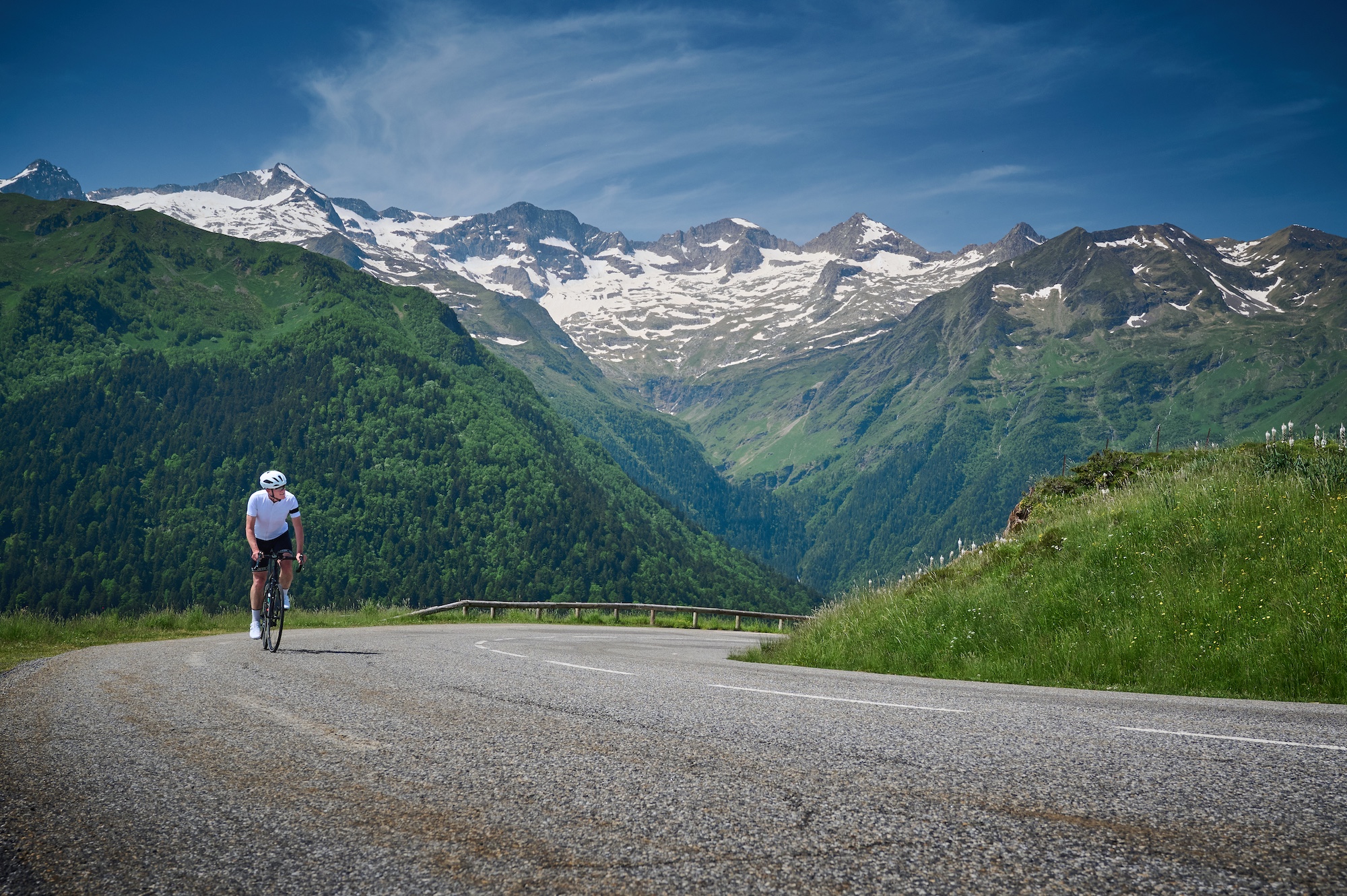
We rode the legendary climb that has been missing from the Tour de France for 36 years: Superbagnères is now back for 2025
Superbagnères returns to the Tour after 36 years. We take on the iconic Pyrenean climb to explore its enduring legacy – and to get a taste for what it holds in store for the peloton
For long-time bike racing fans, particularly those who started following the sport in the Channel 4 era of the mid-1980s, Superbagnères evokes two famous moments. The first came in 1986 – widely regarded as the best Tour de France vintage of all time – when the mountain provided the setting for an extraordinary duel between La Vie Claire team-mates Bernard Hinault and Greg LeMond. The American won the stage as the Frenchman just about hung on to the yellow jersey.
Three years later, Philippa York (then known as Robert Millar) took her third Tour stage victory, while Laurent Fignon nudged LeMond out of the yellow jersey in the midst of their ding-dong battle that ran all the way to the Champs-Élysées.
York’s victory 36 years ago was the Tour’s last visit to the climb – but it is back with a bang this year. On Saturday 19 July, stage 14, the peloton will climb up to its 1,804m summit, bringing down the curtain on a triptych of Pyrenean stages, and waking this mythic mountain from its slumber. When race director Christian Prudhomme announced the return of Superbagnères to the Tour route at the event’s presentation in Paris, the momentousness did not go unnoticed.
Not only was it back, it was hosting one of the race’s key stages, which, as Prudhomme underlined, will trace the route of that legendary day in 1986. Starting in Pau and covering 182.6km, the peloton has 4,950m of climbing to tackle – including the Tourmalet (2,115m), Aspin (1,489m) and Peyresourde (1,569m) passes – before finally taking on the long-lost jewel, Superbagnères.
The name translates as ‘above Bagnères’, and as we approach the town of Bagnères-de-Luchon, the meaning becomes obvious: a cable car rises to the imposing Grand Hôtel that dominates the winter sports resort. For those of us who love riding in the mountains, Bagnères-de-Luchon, or Luchon as it’s more generally known, has a strong claim to being the best located town in the French Pyrenees.
For the last decade, I’ve lived in the neighbouring department of the Ariège, just to the east, and have often come to Luchon to explore the best climbs in the region. Head east from the centre of the spa town, towards Spain, and you quickly find yourself climbing the Col de Portillon. Go west and you arrive at the first ramps of the historic Col de Peyresourde and, soon after, the right turn to the magnificently wild Port de Balès. Not far to the south is the Col de Menté, where Luis Ocaña crashed in a mountain squall while leading the 1971 Tour, his abandon handing the initiative to defending champion Eddy Merckx.
After heading upstream along the bank of the rushing River Pique for three kilometres, the road forks. Kicking very hard up to the left is the route towards the Hospice de France, a centuries-old refuge for travellers on an ancient trading route that crosses the high ridge of the Pyrenees to the Benasque valley in Spain. Stay right and the road crosses a modern bridge over the river and begins to climb towards the ski station of Superbagnères.
The latest race content, interviews, features, reviews and expert buying guides, direct to your inbox!
"You don’t have to ride far up an ascent of this kind to understand why four of the sport’s purest climbers have triumphed at Superbagnères"
The climb’s long omission from the Tour has been down to two issues. Firstly, local and departmental government departments have focused on the promotion of Luchon itself via the shop window the race provides. As a result, the spa town has hosted a dozen stage starts and finishes since 1989, most recently the 2018 stage to the Col de Portet, which began with the leading GC riders lined up on an F1-style grid, a bizarre innovation that was quickly binned.
Secondly, the two stone bridges that carried the road across the Pique right at the foot of the climb to Superbagnères weren’t strong enough to handle the weight and size of the Tour’s TV and logistics trucks. When these bridges were further weakened by a heavy vehicle in 2022, work began on a new 60m-span crossing, the Pont de Ravi, which was completed in December 2023. Once opened, Prudhomme wasted no time bringing Superbagnères back into the Tour.
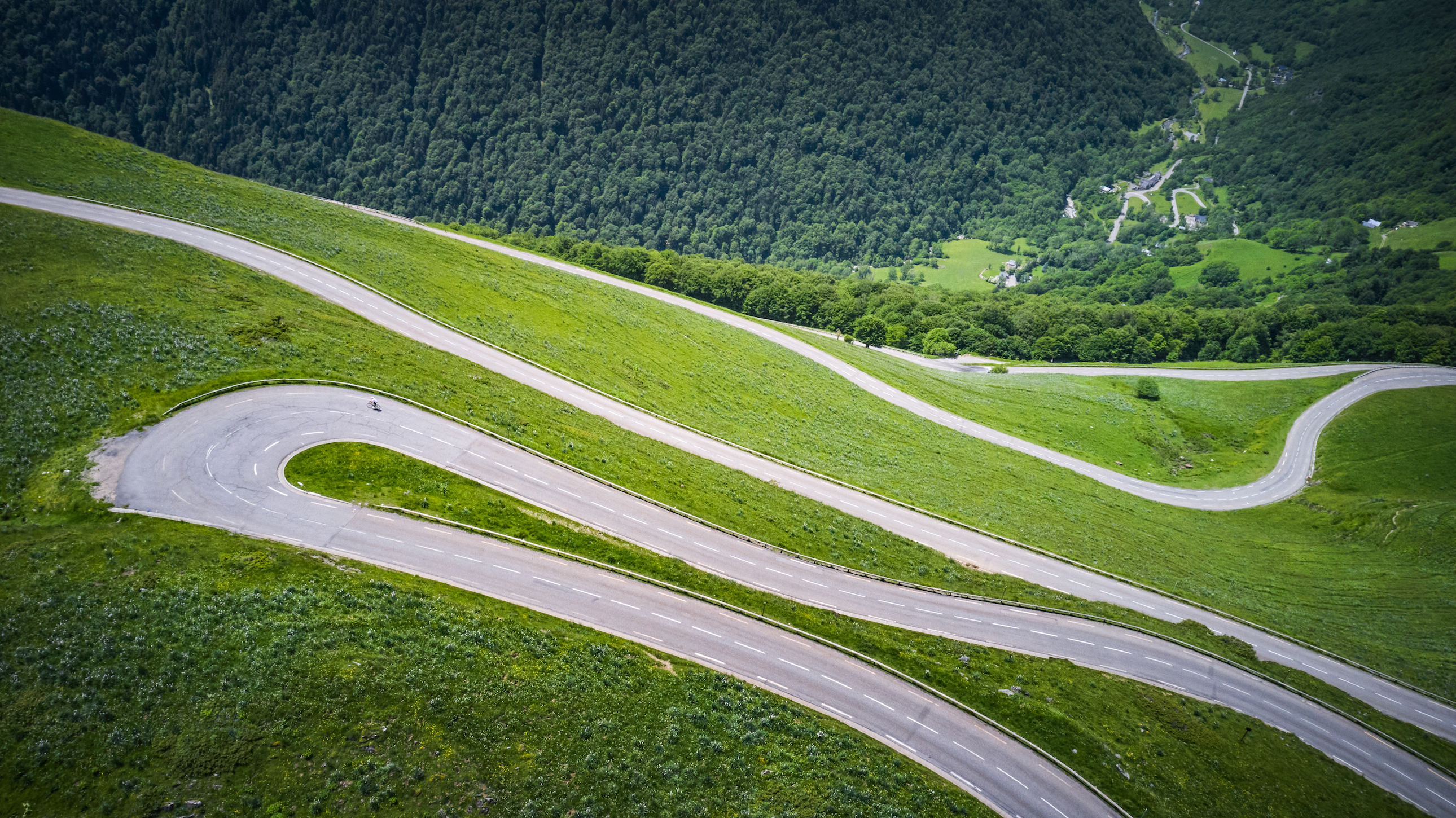
The road to Superbagnères features a pristine set of hairpin bends
After a mid-morning café crème on Luchon’s grand main avenue, I set off south. Record rainfall has doused the French side of the Pyrenees this spring, making the valleys and mountains even lusher than usual. Now, however, the first sustained heat of summer has arrived and I’m soon well warmed up, climbing steadily out of the town, the one steep ramp on this section forcing me out of the saddle for the first time.
Once over the new bridge, the 12.4km ascent to Superbagnères begins with what will become a very familiar pattern: the gradient quickly steepens to 10% for a couple of hundred metres, then eases back to less than half that. In short, this is a typical Pyrenean climb, casse-pattes for the French, rompepiernas for the Spanish – and a leg-breaker for us English-speakers.
You don’t have to ride far up an ascent of this kind to understand why four of the sport’s purest climbers have triumphed at Superbagnères – Italy’s Imerio Massignan in 1961, Spain’s Federico Bahamontes in a time trial from Luchon the following year, his compatriot José Manuel Fuente in 1971, followed by York in 1989.
Fuente’s victory, which came the day after he’d won the hugely dramatic stage into Luchon when Ocaña crashed out in yellow, epitomised the difficulty of the Superbagnères climb. That 1971 stage, a mere 19km-long, was effectively a mass-start mountain time trial, and the shortest road stage in Tour history, running from Luchon to the ski resort. The mercurial Spanish climber attacked three times from a very select group containing new race leader Merckx.
On his third sortie, 5km from the summit, Fuente went clear and finished almost half a minute ahead of Belgian climbing great Lucien Van Impe and future Tour winner Bernard Thévenet, with Merckx a minute back in the company of Joop Zoetemelk. Fuente dedicated the win to Ocaña, “whose absence I feel more than anybody”.
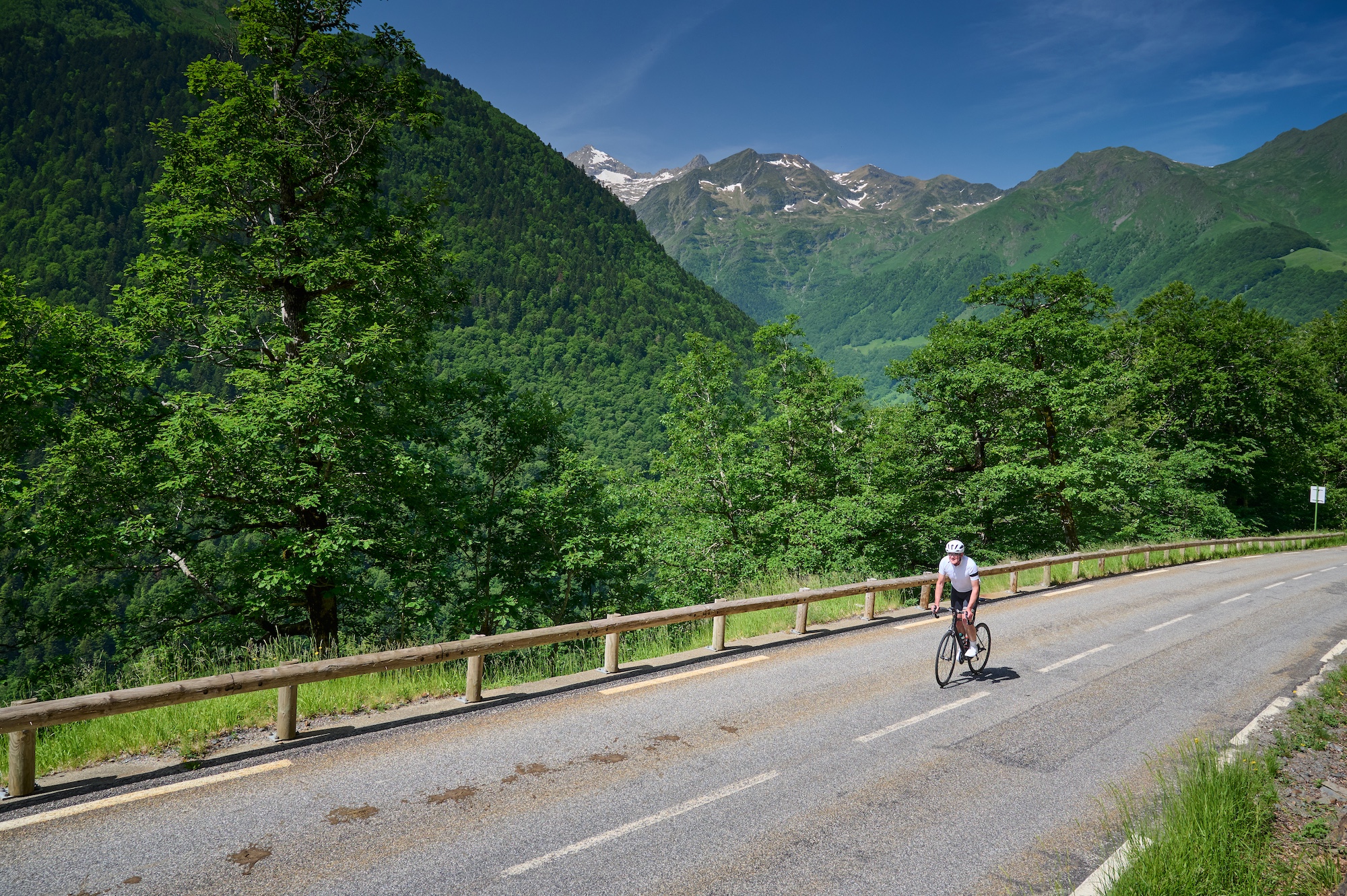
There's a stunning view round every bend on the climb of Superbagnéres
Classically Pyrenean, the road, though newly resurfaced, is rough. Like the gradient, the gravelly carpet tugs at your reserves. It runs west through thick woodland to begin with, deep in a narrow valley carved out by the rushing waters of the River Lys, which flows into the Pique just above the Pont de Ravi. The frequent steeper pitches thwart any attempt to maintain a steady rhythm, at least for an 80kg climber like me, but they do lead on to much easier sections that provide the opportunity to recuperate.
The first significant change comes as the road rises away from the river, the valley gradually widening as it approaches the first string of hairpins at L’Ourson. At the first of the switchbacks, the leftward fork continues up the Lys valley to reach the Cascade d’Enfer – the waterfall of hell. Despite the menacing name, the valley looks inviting, and increasingly so as the bends lift you higher, giving a longer view towards the spectacular 3,000m peaks that delineate the frontier, the melting snow feeding the waterfall that can be heard before, a little higher up, it becomes visible.
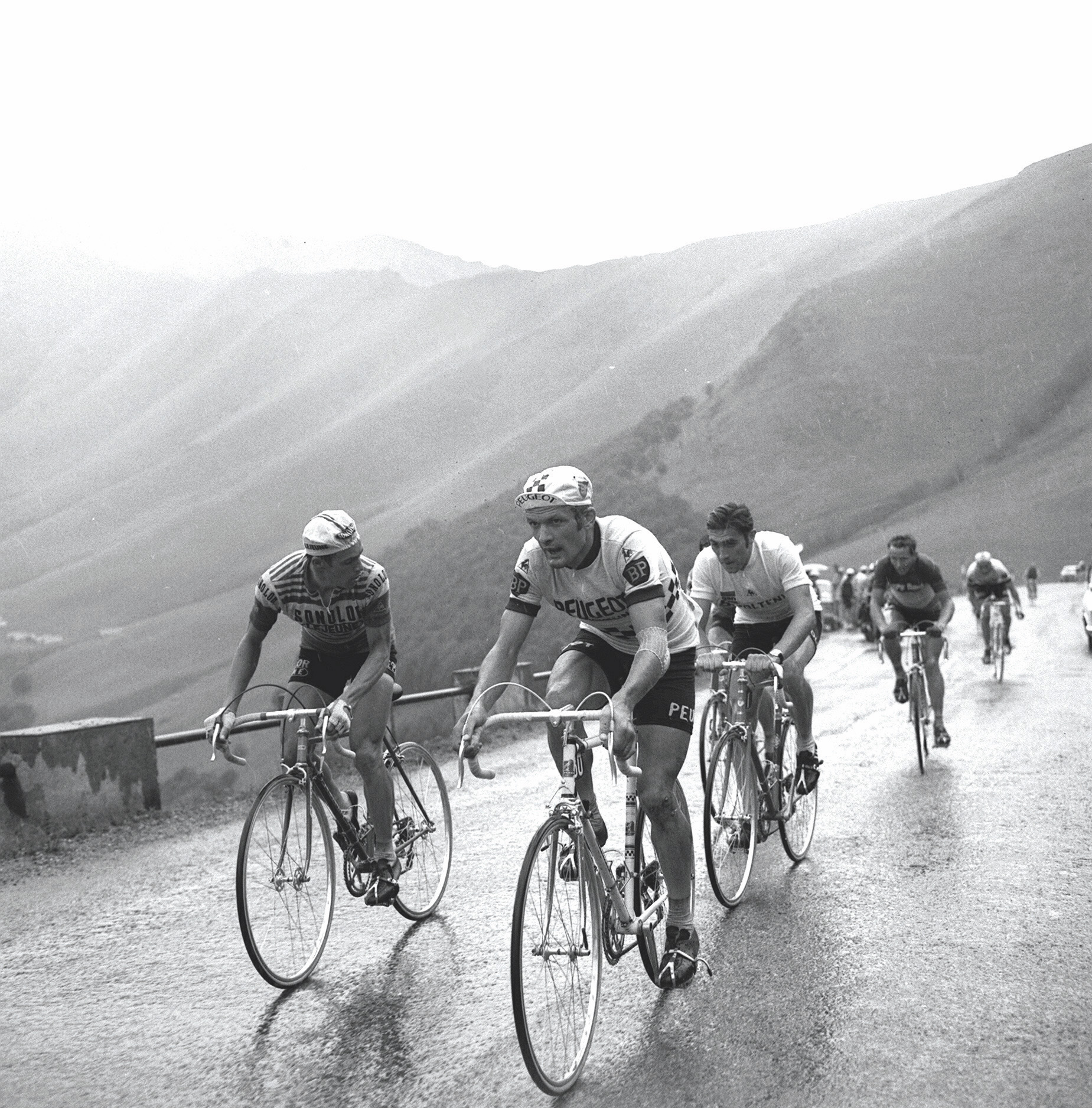
Eddy Merckx climbs with Lucien Van Impe and Bernard Thevenet on an extraordinary 19km stage up Superbagnères in 1971
Now travelling east, the road has been carved into the mountainside and is more open. On a hot July afternoon, this section will be in the full glare of the sun. It now winds a little more, a trait I always like in a climb, as I can set my sights on the next corner and not get daunted by seeing too far ahead. The gradient fluctuates less now, although the angle of attack is more consistently taxing.
With another two hairpins behind me, I finally emerge from the trees and the full glory of the climb begins to reveal itself, soaring, snow-covered peaks filling the view to the south, providing the most magnificent distraction from the incline, which is now unrelentingly between eight and 10%, perfect terrain for an attack by a punchy climber – Tadej Pogačar springs to mind. I can well imagine the Slovenian licking his lips as he recced this climb, particularly the steeper gradients of this section. With the turbo diesel power of team-mate João Almeida to set him up, the defending champion could whittle down his rivals, then scatter the rest of them with one trademark acceleration.
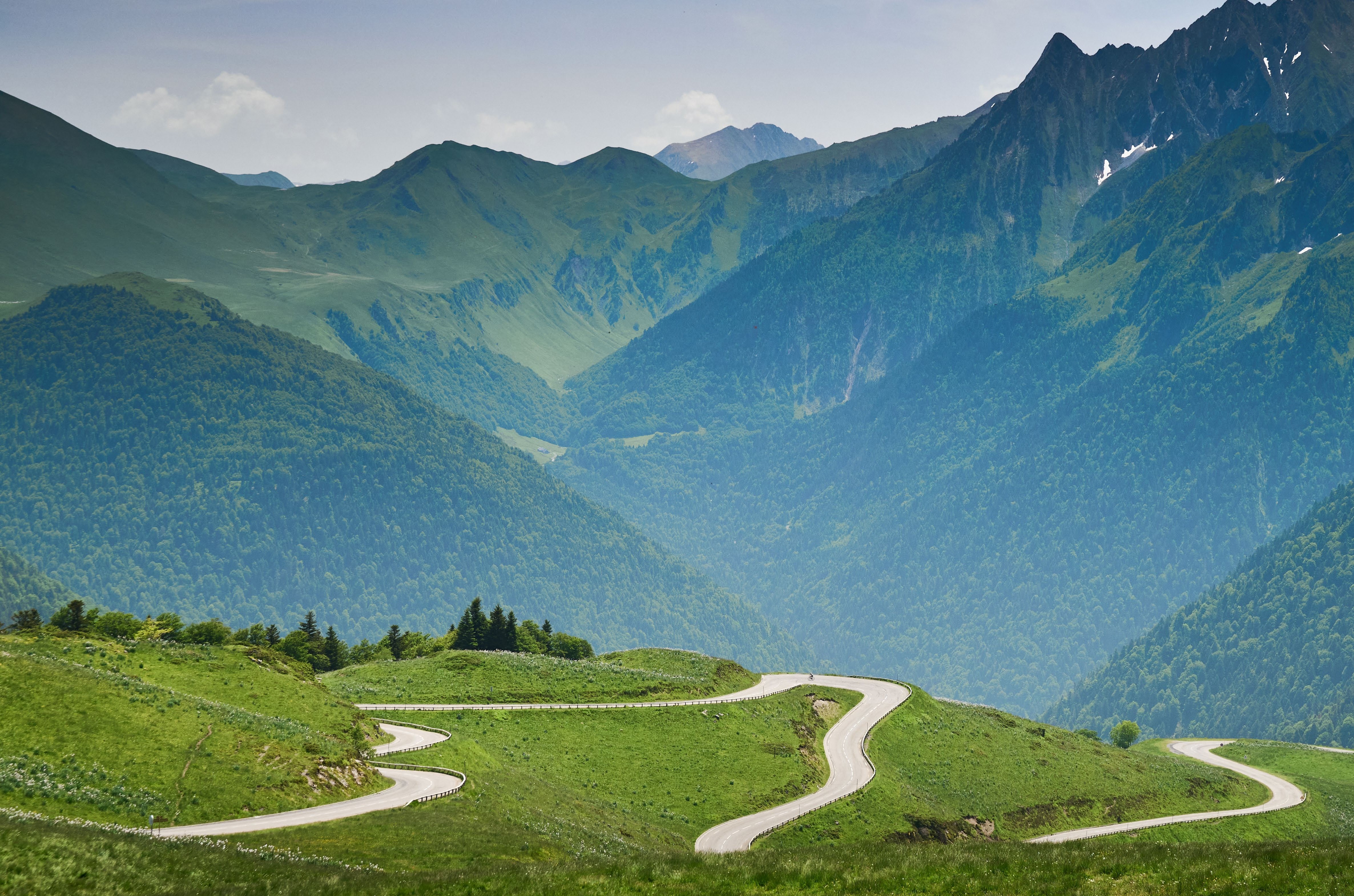
Superbagnéres is slap bang in the middle of the Pyrenean range
Now that I’m above the treeline, I can look down on the latest rise of hairpins I’ve negotiated, laid out below me like asphalt spaghetti. Up ahead, the six-story art deco Grand Hôtel, which opened in 1922 with an orchestral concert in its ballroom, is revealed for the first time. Although the summit is within sight, it’s not easily gained. The road climbing to the top cuts through the estives, the pasture where cattle and horses graze through the summer months.
Once through the final hairpin, which sweeps in a long curve past the first car park and ski lifts, I reach the final and toughest kilometre on the whole climb. Averaging close to 10%, it was here, during that fabled 1989 Tour, that Philippa York sprinted away from breakaway companion Pedro Delgado to win the stage. Three minutes later, Laurent Fignon edged away from yellow jersey Greg LeMond to gain a dozen seconds, a margin that would ultimately prove short of the famous eight seconds by which he’d end up losing the race.
"The reward is one of the most outstanding viewpoints anywhere in the Pyrenees"
With a strong breeze blowing from the north, over the hotel and down the final straight, the steep gradient feels even more acute, and I slowly claw my way towards the summit. My reward is one of the most outstanding viewpoints anywhere in the Pyrenees, a 360º panorama that is well worth the effort and makes Superbagnères one of cycling’s great climbs.
It will undoubtedly provide a severe test when the Tour’s stars follow the route of that famous 1986 stage on 19 July, and, as history tells us, it’s tough enough to swing the battle for the yellow jersey decisively. In the past, Superbagnères has favoured pure climbers; that augurs well for the likes of Tadej Pogačar and Jonas Vingegaard, but less so for a contender like Remco Evenepoel, who prefers to hold a steady tempo when ascending. Whatever happens on Saturday, the show will be spectacular. It’s super by name and super by nature.
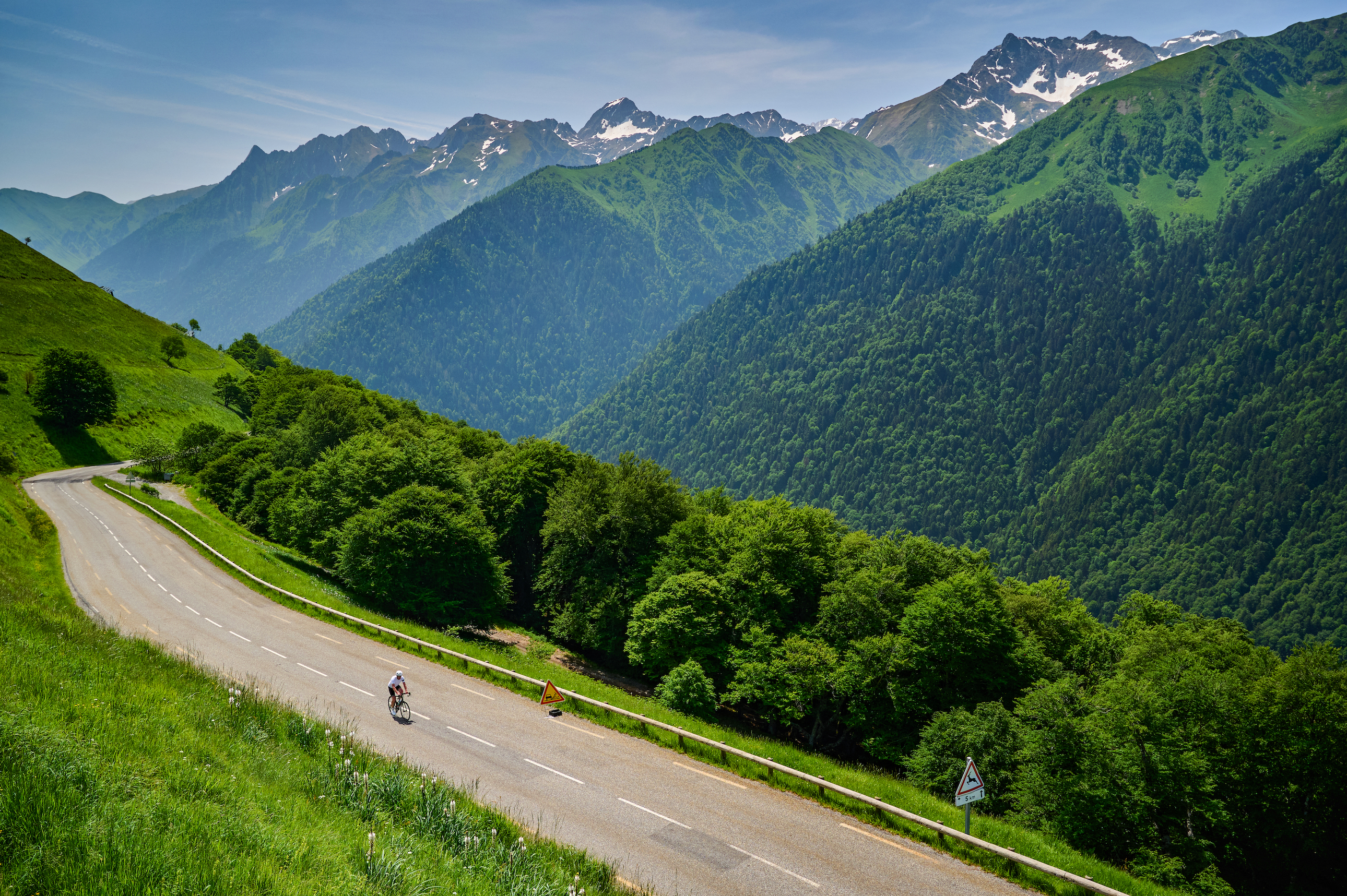
How to get there: The nearest airport is Lourdes–Tarbes, though flights from the UK are limited. Toulouse is a safer bet, with frequent connections and a 90min drive to the climb’s base in Luchon.
Where to stay & when: Stay in Bagnères-de-Luchon, the closest hub with a mix of hotels, B&Bs, cafés and spas – just 12km below Superbagnères. Alternatively, scour the local villages for rental homes. Mid-June to early September offers the most reliable weather, with warmer temperatures and reduced risk of storms, downpours or road closures.
Regional highlights: Refuel on hearty Pyrenean cuisine – think garbure stew, mountain cheeses, and local trout. Visit the thermal baths post-ride, explore scenic cols like Port de Balès and Peyresourde, or ride into Spain via the Col du Portillon for cross-border adventure.
36 – Years since it last featured in the race.
12.7km – Length of the climb, from the Pont de Ravi. 1,804m – Altitude at the summit.
7.3% – Average gradient. 12% – Maximum gradient in the first and last kilometres.
36min 18sec – The Strava KOM, set by Ben O’Connor on 14 May, 2025.
6 – Tour de France inclusions: four road stages (1961, 1971, 1986 and 1989) and two mountain time trials from Luchon (1962 and 1979).
This feature originally appeared in the 17 July 2025 print edition of Cycling Weekly, on sale in newsagents and supermarkets, priced £3.35. You can subscribe through this link here.